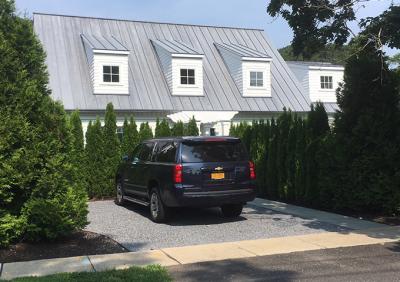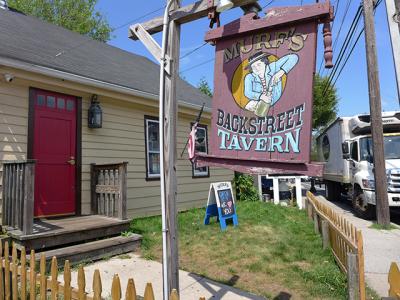‘Maxed Out’ but Wanting a Little More
‘Maxed Out’ but Wanting a Little More

A small garage proposed on a 0.3-acre property may require “one variance too far,” the chairman of the East Hampton Village Zoning Board of Appeals said on Friday, after three neighbors complained about what they said was excessive coverage on the lot.
John and Mary Pizzo want to construct a detached garage at 37 Church Street, which would require variances, as it would fall within the required 10-foot side and rear-yard setbacks. The Pizzos would also need a variance allowing 150 feet of lot coverage over what is allowed.
The Pizzos plan to relocate a driveway from in front of the house, which does not require variance relief, in conjunction with the proposed garage, which is to be tucked in the lot’s corner. A request to permit two curb cuts on the parcel, which has less than the minimum frontage required to permit a second curb cut, was withdrawn before the hearing.
Madeline VenJohn, an attorney, told the board that four of five adjacent properties have accessory structures as close, or closer, to lot lines as her clients’ proposed garage. “It’s the way this neighborhood traditionally was built,” she said, “small garages in the back corner in order to preserve some yard space, instead of having a lot of useless space behind the garage.”
Board members were in favor of the new driveway. But, said Frank Newbold, the board’s chairman, the board had received a “strong letter of objection from neighbors” at 24 Maidstone Avenue, who noted that the applicants had purchased the property, torn down the existing house, and replaced it with a residence “built to the maximum coverage” allowed by the current zoning code. The property is also for sale, he said. “The question raised by the neighbor is, is relief sought for potential economic gain on the sale of the real estate?”
Ms. VenJohn said it was not. “As to whether it’s for sale or not, he uses the house and would like some outdoor storage,” she said.
Lys Marigold, the board’s vice chairwoman, asked if the proposed structure is “really a garage” or for outdoor storage.
“We’re calling it a garage,” Ms. VenJohn said, “because it’s a little bigger than your average outdoor shed. But you couldn’t fit a large car in it.” The structure as proposed has a garage door, and the driveway will lead to it, she said.
“I get what the neighbor’s talking about,” said John McGuirk, of the board. “They came, they maxed this house out, they didn’t leave any room for their shed or the garage, but they got their swimming pool. . . . Maybe they should have come to us before they did this.”
“This is a better configuration of the property,” Ms. Marigold said. “We just don’t like that you max out on coverage and then come for a variance.”
Mr. Newbold agreed, finding it “a little disturbing” that, “as with many redevelopment projects in the village, they are redeveloped to the max, and then after the fact they come in and ask for additional. The point the neighbor is raising is, they should have planned this in.”
Perhaps, board members suggested, the applicants should ask for a storage shed instead of a garage, minimizing or eliminating required variance relief. But “We do want it to be capable of holding a car,” Ms. VenJohn said. “I’m not sure that the applicant would still be interested in moving around the driveway if he’s not able to do the garage.”
A majority of the board appeared satisfied with the garage’s location in a corner of the property, which Mr. McGuirk agreed is traditional in the village. The variance request was minimal, Mr. Newbold said, and maintaining a single curb cut “solves the major part of the neighbor’s objection,” a detriment to the neighborhood’s character.
But two other neighbors were in attendance and addressed the board. Alexandra Skellet of 33 Church Street said that her neighbors’ property “is a new construction, it’s been on the market for over a year, and it’s currently rented out to seasonal tenants.” The applicants, she said, “had the opportunity at the design and building-permit stage to seek these variances.”
It is “not in the best interests of the community” to allow “a new structure that’s already on a very crowded lot,” Ms. Skellet said. “We’re all on small lots . . . but hasn’t he already taken the most of what he can get out of that property?”
Another neighbor, John Faulhaber, said that he has lived at 40 Maidstone Avenue for 66 years and that it had been in his family’s possession for 75 years. “My position is that the property has more than met its buildable capacity,” he said. “Any further building or development would cause a crowding problem.” The Pizzos, he said, “have demolished the old residence, built a house which has doubled in the square footage of living area, and added a swimming pool.” Anything else, he said, “would be an imposition to the neighborhood.”
“We’ve now heard from three neighbors,” Mr. Newbold said, each worried about an undesirable change to the character of their neighborhood. The hearing would be left open, he said, and “perhaps the applicant will hear the comments made today and choose to respond. . . . The sense of all three neighbors is the property is maxed out, and that this is just one variance too far.” It is to resume at the board’s next meeting, on Sept. 14.
In a No-Mow Zone
Several determinations were announced at the meeting. Mark Webb and Kevin McCarthy were granted a freshwater wetlands permit and variance to allow 650 feet of linear fencing along the landward edge of a no-mow zone at 123 Egypt Lane. The applicants initially asked that an existing fence remain within the wetlands and a scenic easement granted to the village, but amended their application to request its relocation, which is to follow the upland side of the easement except for a small section. The variance and permit were granted on the condition that a planting plan is implemented and that lighting fixtures and a pile of landscaping debris in the easement are removed.
The board granted David Wine variances to allow alterations to a pre-existing nonconforming building and use at 92 Ocean Avenue. One of 10 co-operative residences at the 2.5-acre property, the alterations include changes in the fenestration and the addition of a dormer, which the co-op board has approved. The number of bedrooms will be reduced from two to one. Because its pre-existing nonconforming location falls within the required side-yard setback and because any alteration to a pre-existing use requires variance relief, the applicant had to apply to the Z.B.A.
Mary Streep’s application for a wetlands permit and variance to allow conversion of a screened porch into habitable area 134 feet from the edge of wetlands, where a 150-foot setback is required, was granted, as was a variance allowing 6,348 square feet of finished living space, where the maximum permitted floor area at 29 Pondview Lane is 5,800 square feet.
The board denied Frederick Ayer’s application for variances to construct a swimming pool 28 feet from the side lot line, 32 feet from the rear lot line, and 107.3 feet from wetlands at 81 Ocean Avenue, where the required side and rear-yard setbacks are 40 feet and the required wetlands setback is 150 feet. The applicant had also sought to construct pool equipment, a retaining wall, and drywells within the wetlands setback, which were also denied.







